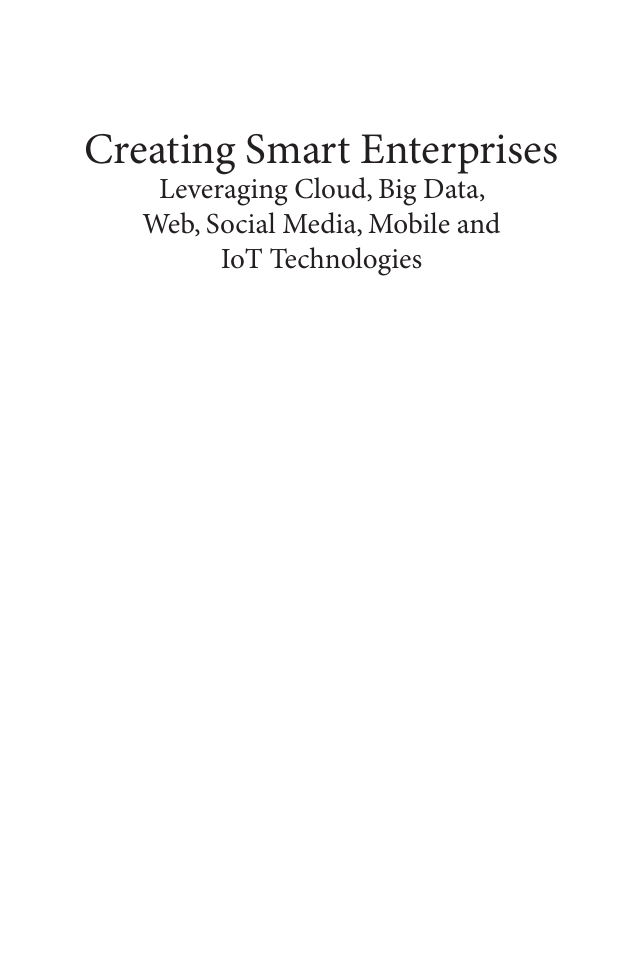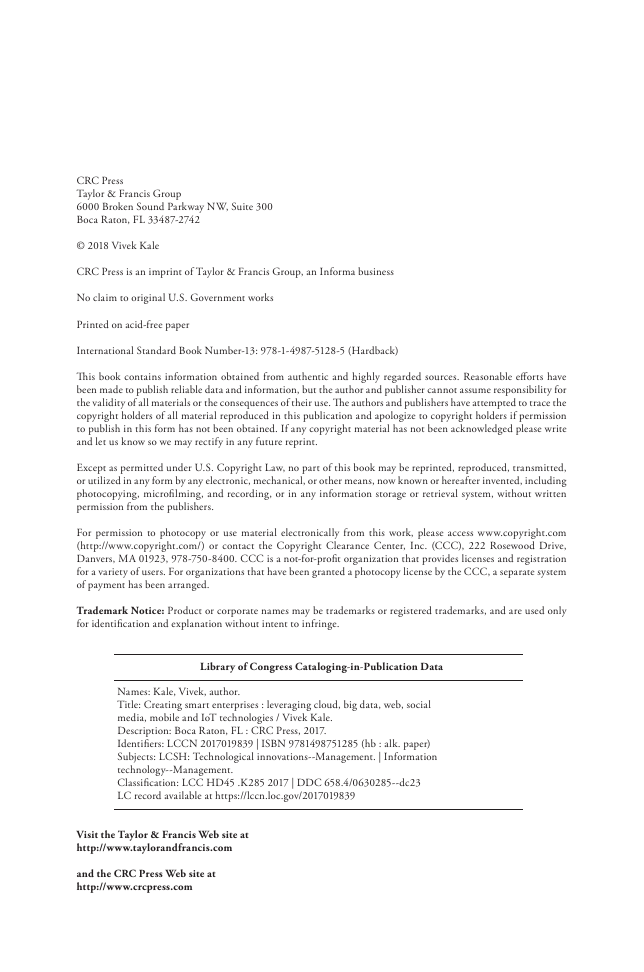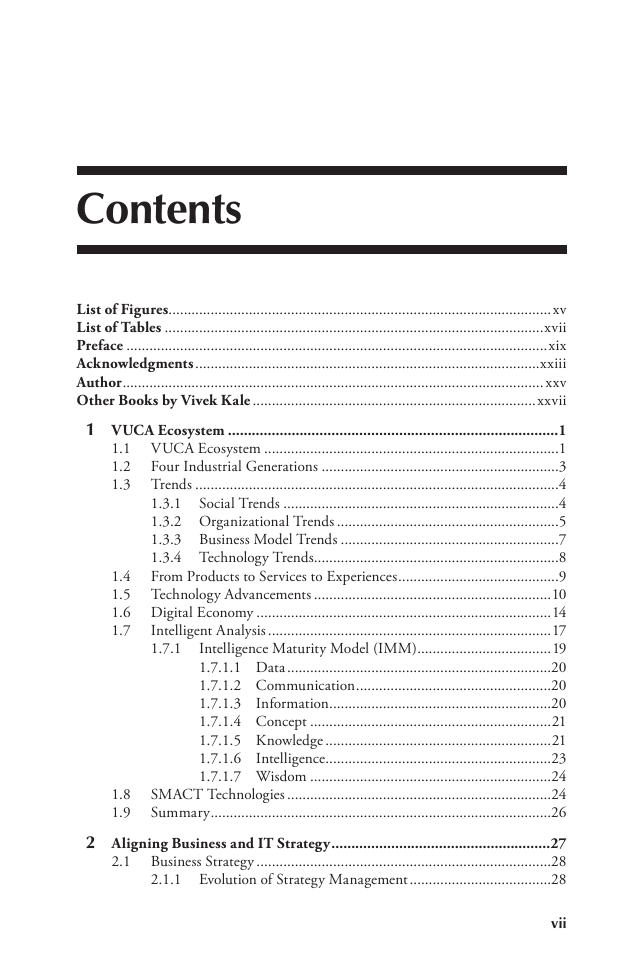Cover
Half Title
Title Page
Copyright Page
Dedication
Table of Contents
List of Figures
List of Tables
Preface
Acknowledgments
Author
Other Books byVivek Kale
1: VUCA Ecosystem
1.1 VUCA Ecosystem
1.2 Four Industrial Generations
1.3 Trends
1.3.1 Social Trends
1.3.2 Organizational Trends
1.3.3 Business Model Trends
1.3.4 Technology Trends
1.4 From Products to Services to Experiences
1.5 Technology Advancements
1.6 Digital Economy
1.7 Intelligence Analysis
1.7.1 Intelligence Maturity Model (IMM)
1.7.1.1 Data
1.7.1.2 Communication
1.7.1.3 Information
1.7.1.4 Concept
1.7.1.5 Knowledge
1.7.1.6 Intelligence
1.7.1.7 Wisdom
1.8 SMAC Technologies
1.9 Summary
2: Aligning Business and IT Strategy
2.1 Business Strategy
2.1.1 Evolution of Strategy Management
2.1.2 Sustaining Competitive Advantage
2.1.2.1 Competitive Priorities
2.1.2.2 Porter’s Five Forces Model
2.1.2.3 Porter’s Framework of Generic Strategies
2.1.2.4 Porter’s Value Chain
2.2.1 Evolution of IT
2.2.2 Evolution of IS
2.2.3 IS/IT Governance
2.2.3.1 Alignment IT/IS with Business Strategy
2.2.3.2 Aligning Business Goals and IT Goals
2.2.3.3 Aligning business with IT/IS and Business Value from IT
2.2.3.4 Governance Frameworks
2.1.1 Evolution of Strategy Management
2.3 Summary
3: Enterprise Security Technologies
3.1 Concept of Security
3.1.1 The Triad of Confidentiality, Integrity, and Availability
3.1.1.1 Confidentiality
3.1.1.2 Integrity
3.1.1.3 Availability
3.1.2 Types of Attacks
3.1.2.1 Interception
3.1.2.2 Interruption
3.1.2.3 Modification
3.1.2.4 Fabrication
3.1.3 Threats, Vulnerabilities, and Risk
3.1.3.1 Threats
3.1.3.2 Vulnerabilities
3.1.3.3 Risk
3.1.4 Controls
3.1.4.1 Physical
3.1.4.2 Logical
3.1.4.3 Administrative
3.1.5 Defense in Depth
3.2 Identification
3.2.1 Identity Verification
3.2.2 Identity Falsification
3.3 Authentication
3.3.1 Mutual Authentication
3.3.2 Multi-factor Authentication
3.4 Authorization
3.5 Access Control
3.5.1 Access Control Models
3.6 Accountability
3.6.1 Non-repudiation
3.6.2 Deterrence
3.6.3 Intrusion Detection and Prevention
3.6.4 Admissibility of Records
3.7 Audit
3.7.1 Logging
3.7.2 Monitoring
3.7.3 Assessments
3.8 Summary
4: Process-Driven Organization
4.1 Process-Oriented Enterprise
4.1.1 Value-Add Driven Enterprise
4.2 Concept of Business Process Management (BPM)
4.2.1 Business Process
4.3 Business Process Management (BPM)
4.4 Enterprise BPM Methodology
4.4.1 Strategic Planning for Enterprise BPM
4.4.1.1 Identifying the Business Processes in the Company
4.4.2 Selecting Business Processes for BPM
4.4.3 Creating Process Maps
4.4.4 Analyzing Processes for Breakthrough Improvements
4.4.5 Innovative Breakthrough Improvement in Processes
4.4.6 Implementing Designed Processes
4.4.7 Measuring the Performance of Designed Processes
4.5 Business Process Reengineering (BPR)
4.6 Management by Collaboration (MBC)
4.7 Collaboration Technologies
4.7.1 Synchronous Communication Tools
4.7.2 Asynchronous Communication Tools
4.8 Social Software and Collaborative Systems and Tools
4.8.1 Skype
4.8.2 Dropbox
4.8.3 Google Drive and Google Docs
4.8.4 Microsoft SkyDrive
4.8.5 Microsoft OneNote
4.9 Summary
5: Analytics
5.1 Decisions
5.1.1 Types of Decisions
5.1.2 Scope of Decisions
5.2 Decision-Making Process
5.3 Decision-Making Techniques
5.3.1 Mathematical Programming
5.3.2 Multi-criteria Decision Making
5.3.3 Case-based Reasoning
5.3.4 Data Warehouse and Data Mining
5.3.5 Decision Tree
5.3.6 Fuzzy Sets and Systems
5.4 Decision Support Systems
5.4.1 Multi-Source Driven DSSs
5.4.2 Generic DSS Architecture
5.5 Analytics
5.5.1 Descriptive Analytics
5.5.2 Predictive Analytics
5.5.3 Prescriptive Analytics
5.6 Data Science Techniques
5.6.1 Database Systems
5.6.2 Statistical Inference
5.6.3 Regression and Classification
5.6.4 Data Mining and Machine Learning
5.6.5 Data Visualization
5.6.6 Text Analytics
5.6.7 Time Series and Market Research Models
5.7 Snapshot of Data Analysis Techniques and Tasks
5.8 Summary
6: Cloud Computing Basics
6.1 Cloud Definition
6.2 Cloud Characteristics
6.2.1 Cloud Storage Infrastructure Requirements
6.3 Cloud Delivery Models
6.3.1 Infrastructure as a Service (IaaS)
6.3.2 Platform as a Service (PaaS)
6.3.3 Software as a Service (SaaS)
6.4 Cloud Deployment Models
6.4.1 Private Clouds
6.4.2 Public Clouds
6.4.3 Hybrid Clouds
6.4.4 Community Clouds
6.5 Cloud Benefits
6.6 Cloud Technologies
6.6.1 Virtualization
6.6.1.1 Characteristics of Virtualized Environment
6.6.2 Service-Oriented Computing
6.6.2.1 Advantages of SOA
6.6.2.2 Layers in SOA
6.6.3 Business Processes with SOA
6.6.3.1 Process
6.6.3.2 Workflow
6.6.3.3 Business Process Management (BPM)
6.6.3.4 Business Processes via Web Services
6.7 Summary
7: Big Data Computing
7.1 Big Data
7.1.1 What Is Big Data?
7.1.1.1 Data Volume
7.1.1.2 Data Velocity
7.1.1.3 Data Variety
7.1.1.4 Data Veracity
7.1.2 Common Characteristics of Big Data Computing Systems
7.1.3 Big Data Appliances
7.2 Tools and Techniques of Big Data
7.2.1 Processing Approach
7.2.2 Big Data System Architecture
7.2.2.1 Brewer’s CAP (Consistency Availability Partition) Theorem
7.2.2.2 BASE (Basically Available, Soft State, Eventual Consistency)
7.2.2.3 Functional Decomposition
7.2.2.4 Master–Slave Replication
7.2.3 Row Partitioning or Sharding
7.2.4 Row versus Column-Oriented Data Layouts
7.2.5 NoSQL Data Management
7.2.6 In-Memory Computing
7.2.7 Developing Big Data Applications
7.3 NoSQL Databases
7.3.1 Column-Oriented Stores or Databases
7.3.2 Key–Value Stores (K–V Store) or Databases
7.3.3 Document-Oriented Databases
7.3.4 Graph Stores or Databases
7.4 Aadhaar Project
7.5 Summary
8: Web Applications
8.1 Web-Based Applications
8.1.1 Reference Architecture
8.1.1.1 User Interaction Architecture
8.1.1.2 Service-Based Architecture
8.1.1.3 Business Object Architecture
8.1.2 Realization of the Reference Architecture in J2EE
8.1.2.1 JavaServer Pages and Java Servlets as the User Interaction Components
8.1.2.2 Session Bean EJBs as Service-Based Components
8.1.2.3 Entity Bean EJBs as the Business Object Components
8.1.2.4 Distributed Java Components
8.1.2.5 J2EE Access to the EIS (Enterprise Information Systems) Tier
8.1.3 Model–View–Controller Architecture
8.2 Evolution of the Web
8.2.1 Web 1.0
8.2.2 Web 2.0
8.2.3 Web 3.0
8.2.4 Mobile Web
8.2.5 The Semantic Web
8.2.6 Rich Internet Applications
8.3 Web Applications
8.3.1 Web Applications Dimensions
8.4 Search Analysis
8.4.1 SLA Process
8.5 Web Analysis
8.5.1 Veracity of Log Files data
8.5.1.3 Visit Duration
8.5.2 Web Analysis Tools
8.5.3 Common Analysis and Reports
8.6 Summary
9: Social Network Applications
9.1 Networks
9.1.1 Concept of Networks
9.1.2 Principles of Networks
9.1.2.1 Metcalfe’s Law
9.1.2.2 Power Law
9.1.2.3 Small Worlds Networks (SWNs)
9.2 Computer Networks
9.2.1 Internet
9.2.2 World Wide Web (WWW)
9.3 Social Networks
9.3.1 Popular Social Networks
9.3.1.1 LinkedIn
9.3.1.2 Facebook
9.3.1.3 Twitter
9.3.1.4 Google+
9.3.1.5 Other Social Networks
9.4 Social Network Analysis (SNA)
9.5 Text Analysis
9.5.1 Defining Text Analysis
9.5.1.1 Document Collection
9.5.1.2 Document
9.5.1.3 Document Features
9.5.1.4 Domain Knowledge
9.5.1.5 Search for Patterns and Trends
9.5.1.6 Results Presentation
9.6 Sentiment Analysis
9.6.1 Sentiment Analysis and Natural Language Processing (NLP)
9.6.2 Applications
9.7 Summary
10: Mobile Applications
10.1 Mobile Computing Applications
10.1.1 Generations of Communication Systems
10.1.1.1 1st Generation: Analog
10.1.1.2 2nd Generation: CDMA, TDMA and GSM
10.1.1.3 2.5 Generation: GPRS, EDGE and CDMA 2000
10.1.1.4 3rd Generation: wCDMA, UMTS, and iMode
10.1.1.5 4th Generation
10.1.2 Mobile Operating Systems
10.1.2.1 Symbian
10.1.2.2 BlackBerry OS
10.1.2.3 Google Android
10.1.2.4 Apple iOS
10.1.2.5 Windows Phone
10.2 Mobile Web Services
10.2.1 Mobile Field Cloud Services
10.3 Context-Aware Mobile Applications
10.3.1 Ontology-Based Context Model
10.3.2 Context Support for User Interaction
10.4 Mobile Web 2.0
10.5 Mobile Analytics
10.5.1 Mobile Site Analytics
10.5.2 Mobile Clustering Analysis
10.5.3 Mobile Text Analysis
10.5.4 Mobile Classification Analysis
10.5.5 Mobile Streaming Analysis
10.6 Summary
11: Internet of Things (IoT) Technologies
11.1 Internet of Things
11.1.1 IoT Building Blocks
11.1.2 IoT Architecture
11.2 RFID (Radio Frequency Identification)
11.3 Wireless Sensor Networks
11.3.1 Wireless Networks
11.3.2 Sensor
11.3.3 Wireless Sensor Networks
11.3.3.1 WSN Characteristics
11.3.3.2 WSN Design Challenges
11.3.3.3 WSN Design Objectives
11.3.3.4 WSN Architecture
11.4 Sensor Data Processing
11.4.1 Sensor Data-Gathering and Data-Dissemination Mechanisms
11.5 Sensor Database
11.6 Summary
Appendix A: Internet as Extended Brain
References
Index
















 2023年江西萍乡中考道德与法治真题及答案.doc
2023年江西萍乡中考道德与法治真题及答案.doc 2012年重庆南川中考生物真题及答案.doc
2012年重庆南川中考生物真题及答案.doc 2013年江西师范大学地理学综合及文艺理论基础考研真题.doc
2013年江西师范大学地理学综合及文艺理论基础考研真题.doc 2020年四川甘孜小升初语文真题及答案I卷.doc
2020年四川甘孜小升初语文真题及答案I卷.doc 2020年注册岩土工程师专业基础考试真题及答案.doc
2020年注册岩土工程师专业基础考试真题及答案.doc 2023-2024学年福建省厦门市九年级上学期数学月考试题及答案.doc
2023-2024学年福建省厦门市九年级上学期数学月考试题及答案.doc 2021-2022学年辽宁省沈阳市大东区九年级上学期语文期末试题及答案.doc
2021-2022学年辽宁省沈阳市大东区九年级上学期语文期末试题及答案.doc 2022-2023学年北京东城区初三第一学期物理期末试卷及答案.doc
2022-2023学年北京东城区初三第一学期物理期末试卷及答案.doc 2018上半年江西教师资格初中地理学科知识与教学能力真题及答案.doc
2018上半年江西教师资格初中地理学科知识与教学能力真题及答案.doc 2012年河北国家公务员申论考试真题及答案-省级.doc
2012年河北国家公务员申论考试真题及答案-省级.doc 2020-2021学年江苏省扬州市江都区邵樊片九年级上学期数学第一次质量检测试题及答案.doc
2020-2021学年江苏省扬州市江都区邵樊片九年级上学期数学第一次质量检测试题及答案.doc 2022下半年黑龙江教师资格证中学综合素质真题及答案.doc
2022下半年黑龙江教师资格证中学综合素质真题及答案.doc